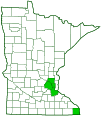Parker’s thread-waisted wasp
(Prionyx parkeri)
Conservation • Description • Habitat • Ecology • Distribution • Taxonomy
|
|
||||||||||||||
Description |
Parker’s thread-waisted wasp is a medium-sized, solitary, ground-nesting, thread-waisted wasp. It occurs throughout the United States and in northern Mexico. It is more common in the south, uncommon in Minnesota. Adults are found in fields, where they feed on flower nectar. Larvae feed on paralyzed grasshoppers. Adult males are about 7⁄16″ (10.5 mm) long. Females are much larger, averaging 11⁄16″ (18 mm) in length. The base of the abdomen is contracted into a thin stalk, making the body appear “thread-waisted”. This is the feature that gives the family Sphecidae its common name. The head is black and is covered with short, erect, white hairs. There are two large compound eyes, one on each side of the head; and three small simple eyes (ocelli) in a triangular pattern at the top of the head between the compound eyes. The antennae are thread-like, black, and about as long as the head and thorax combined. They are not elbowed. There are twelve antennal segments on the female, thirteen segments on the male. The first segment is shorter than the third. On the male, segments five through eight have a plate (fossula) on the side. The face is thinly covered with silvery, appressed hairs. The plate on the face above the upper lip (clypeus) is black on both sexes. The upper margin is concave, the lower margin is notched in the middle. There is a large, hairless, dimpled area around the notch. On the male the finger-like mouthparts attached to the under jaws (maxillary palps) are longer than those attached to the lower lip (labial palps). On the female the maxillary and labial palps are about equal in length. The front part of the body (mesosoma) consists of the three segments of the thorax and the first segment of the abdomen, which is fused to the thorax. This gives the thorax the appearance of having four segments. The mesosoma is is entirely black, with no silver markings, and is covered with short, white, erect hairs. The upper plate on the first segment of the thorax (pronotum) is short and collar-like. There is a short, rounded lobe on each side of the pronotum that does not reach the plate at the base of the wings (tegula). The lobes are densely covered with hairs. The plates on the sides of the thorax (pleura) are thinly covered with silvery, appressed hairs. The abdomen has seven apparent segments on the male, six apparent segments and a stinger on the female. It consists of a large first segment (propodeum) that is fused to the thorax; a relatively long, narrow, stalk-like second segment (petiole); and the bulbous remainder (gaster). The petiole is black. The gaster is red and is bent downward at the end of the petiole. On the male the basal two-thirds of the first and second segments of the gaster are black above, the sixth segment is black above, and the seventh (last) segment is entirely black. On the female segments four and five are usually black above but the tip of the gaster is always red. Sometimes the gaster on the female is entirely red. The wings are lightly tinted brown. The forewing has three submarginal cells. Only one recurrent (backward-turning) vein meets the second submarginal cell. There are two lobes at the base of the hindwing. The inner lobe (vannal lobe) is large. The discoidal vein on the hindwing rises at the front (anterior) end of the of the transverse median vein. The legs are long, slender, and black. On the middle leg there are two spurs at the tip of the fourth leg segment (tibia). The last part of the leg (tarsus), corresponding to the foot, has five segments. The first segment is slender. There is a pair of claws at the end of the last segment. On the front leg, there are two or more teeth at the base of each claw. |
Size |
Male: 7⁄16″ (10.5 mm) Female: average 11⁄16″ (18 mm) |
Similar Species |
Habitat |
Fields |
Ecology |
Season |
|
Behavior |
The wings are held over the body when at rest. |
Life Cycle |
The female digs a burrow in the ground. She stings a grasshopper, paralyzing it, and places it in the burrow. She then lays a single egg on the body and seals the burrow. When the egg hatches the larva feeds on the paralyzed, still living grasshopper. When it matures the larva pupates in the burrow. |
Larva Food |
Grasshopper nymphs |
Adult Food |
Flower nectar |
Distribution |
||
|
Sources |
|
| 7/12/2024 | ||
Occurrence |
||
|
||
Taxonomy |
|
Order |
Hymenoptera (Ants, Bees, Wasps, and Sawflies) |
Suborder |
Apocrita (Narrow-waisted Wasps, Ants, and Bees) |
Infraorder |
Aculeata (Ants, Bees, and Stinging Wasps) |
Superfamily |
Apoidea (Bees and Apoid Wasps) |
Family |
Sphecidae (thread-waisted wasps) |
Subfamily |
|
Tribe |
Prionychini |
Subtribe |
Prionychina |
Genus |
Prionyx |
Subordinate Taxa |
|
|
|
Synonyms |
|
|
|
Common Names |
|
Parker’s thread-waisted wasp |
|
Glossary
Clypeus
On insects, a hardened plate on the face above the upper lip (labrum).
Gaster
The bulbous part of the abdomen of ants, bees, and wasps. In ants it usually begins at segment three.
Maxillae
Paired mouth structures of arthropods located immediately behind the mandible and used for tasting and manipulating food. “Under-jaws”.
Mesosoma
In Hymenoptera: the front part of the body, consisting of all three segments of the thorax and the first segment of the abdomen, to which the wings are attached.
Ocellus
Simple eye; an eye with a single lens. Plural: ocelli.
Pronotum
The exoskeletal plate on the upper side of the first segment of the thorax of an insect.
Tarsus
On insects, the last two to five subdivisions of the leg, attached to the tibia; the foot. On spiders, the last segment of the leg. Plural: tarsi.
Tegula
A small, hardened, plate, scale, or flap-like structure that overlaps the base of the forewing of insects in the orders Lepidoptera, Hymenoptera, Diptera, and Homoptera. Plural: tegulae.
Tibia
The fourth segment of an insect leg, after the femur and before the tarsus (foot). The fifth segment of a spider leg or palp. Plural: tibiae.
Visitor Photos |
||
Share your photo of this insect. |
||
This button not working for you? |
||
Mike Poeppe |
||
 |
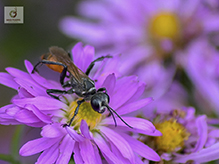 |
|
I found this one today just a mile West of Houston and not sure of what it really is? |
||
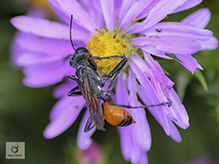 |
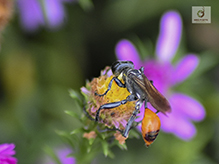 |
|
|
||
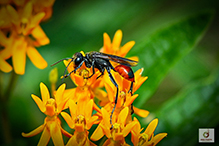 |
|
|
Stacey Wilber |
||
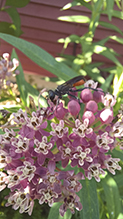 |
||
There were 6 of these on the swamp milkweed in my yard. |
||
MinnesotaSeasons.com Photos |
||
|
||
|
||

Slideshows |
|

Visitor Videos |
||
Share your video of this insect. |
||
This button not working for you? |
||
|
Other Videos |
||
Digger wasp Prionyx - Grasshopper hunter |
About
Sep 6, 2020 Prionyx wasp ( Prionyx parkeri) with a grasshopper. Joy to observe, but very difficult to film - too fast for macro filming! Video taken on 9-04-2020 at Air Station Prairie, Glenview, Illinois. Sorry for the bad quality of the moments when carrying the grasshopper - had to use a camcorder and no time to focus. |
Burrowing Wasp Prionyx parkeri.MOV |
About
Sep 8, 2011 Active August 2011 Peninsula, OH |
Wasp ( Prionyx) VS Grasshopper |
About
Sep 14, 2015 Prionyx wasp paralyzed this grasshopper . I watched when it pounced and stung it just a couple seconds straggle then bite/chew behind the head for couple minutes, chose a site and started67c digging. At the end it made sure that there are no traces of the burrow. and than dug burrow .It lay a egg and when the larva hatches it will have fresh food . This is nature if you think that its cruel to be eaten alive for weeks -don't watch! |

Visitor Sightings |
||
Report a sighting of this insect. |
||
This button not working for you? |
||
| Mike Poeppe 7/11/2024 |
Location: Houston County, MN |
 |
| Stacey Wilber 7/26/2022 |
Location: Anoka County, MN There were 6 of these on the swamp milkweed in my yard. |
 |
| Mike Poeppe 9/20/2021 |
Location: Houston County, MN I found this one today just a mile West of Houston and not sure of what it really is? |
 |
MinnesotaSeasons.com Sightings |
||
|

Created: 10/26/2021 Last Updated: © MinnesotaSeasons.com. All rights reserved. |
